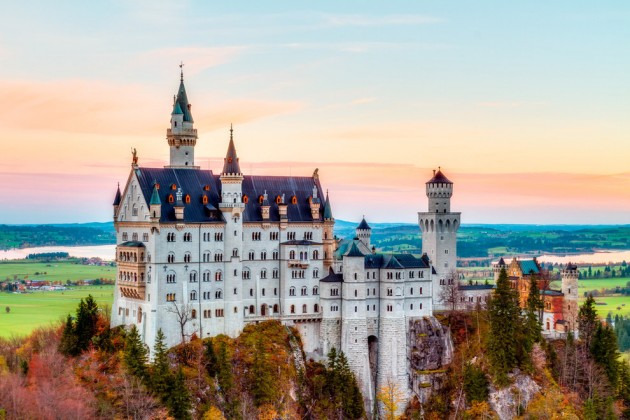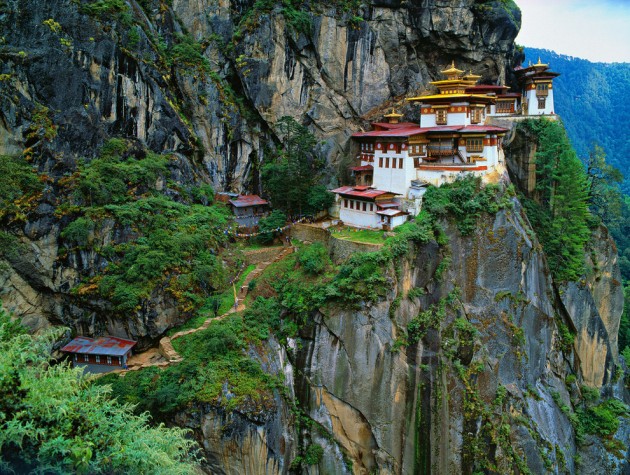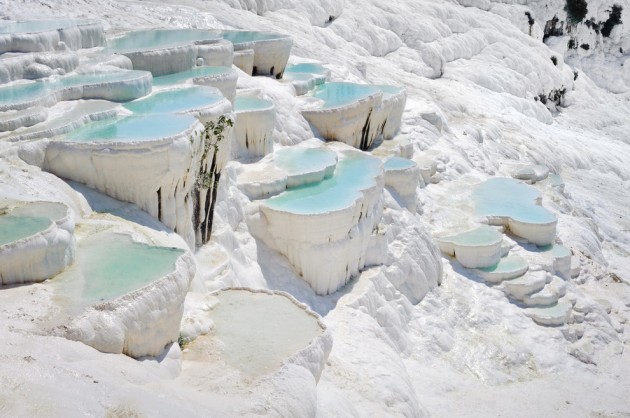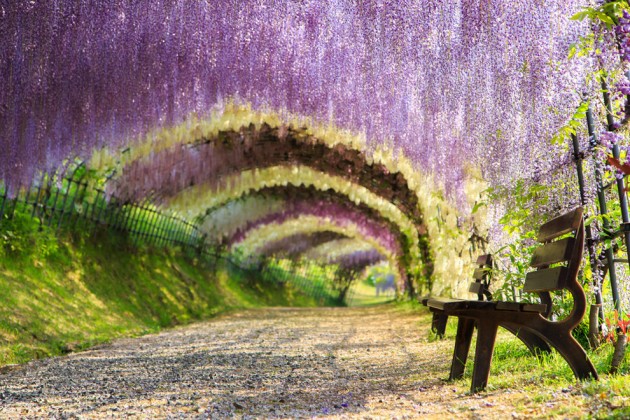Let’s take a break from all these recent contemporary and modern buildings and architecture styles and just travel back in time to the day you were first amazed of some landscapes or buildings in your favorite fairy tales.
That’s exactly what we wanted to show you with this collection of 15 fairy tale places you won’t believe are real.
Just as the title suggests, it is hard to believe this places are real because they look so beautiful just as if they came out of a fairy tale story or movie. Enjoy!
Taj Mahal, India

Photo by: nothing3 on Flickr.com
The Taj Mahal is a white marble mausoleum located in Agra, Uttar Pradesh, India. It was built by Mughal emperor Shah Jahan in memory of his third wife, Mumtaz Mahal. The Taj Mahal is widely recognized as “the jewel of Muslim art in India and one of the universally admired masterpieces of the world’s heritage”. Taj Mahal is regarded by many as the finest example of Mughal architecture, a style that combines elements from Islamic, Persian, Ottoman Turkish and Indian architectural styles.
Las Lajas Sanctuary, Colombia
Photo by: Rafal Cichawa on shutterstock.com
The Shrine of Our Lady of Las Lajas is a Roman Catholic cathedral and basilica church dedicated to the veneration of Our Lady of Las Lajas Ipiales. It is located in southern Colombia and has been a tourism and pilgrimage destination since the eighteenth century.
Saint Basil’s Cathedral, Russia

Photo by: Pavel L on shutterstock.com
The Cathedral of Vasily the Blessed, commonly known as Saint Basil’s Cathedral, is a former church in Red Square in Moscow, Russia. The building, now a museum, is officially known as the Cathedral of the Intercession of the Blessed Virgin on the Moat or Pokrovsky Cathedral. It was built from 1555–61 on orders from Ivan the Terrible and commemorates the capture of Kazan and Astrakhan. It has been the hub of the city’s growth since the 14th century and was the city’s tallest building until the completion of the Ivan the Great Bell Tower in 1600.
Neuschwanstein Castle, Germany
Photo by: Andreas Zerndl on shutterstock.com
Neuschwanstein Castle is a nineteenth-century Romanesque Revival palace on a rugged hill above the village of Hohenschwangau near Füssen in southwest Bavaria, Germany. The palace was commissioned by Ludwig II of Bavaria as a retreat and as a homage to Richard Wagner. Ludwig paid for the palace out of his personal fortune and by means of extensive borrowing, rather than Bavarian public funds.
The palace was intended as a personal refuge for the reclusive king, but it was opened to the paying public immediately after his death in 1886. Since then more than 61 million people have visited Neuschwanstein Castle. More than 1.3 million people visit annually, with as many as 6,000 per day in the summer. The palace has appeared prominently in several movies and was the inspiration for Disneyland’s Sleeping Beauty Castle and later, similar structures.
Colmar, France
Photo by: fonz86 on Flickr.com
Colmar is the third-largest commune of the Alsace region in north-eastern France. It is the seat of the prefecture of the Haut-Rhin department and the arrondissement of Colmar.
The town is situated along the Alsatian Wine Route and considers itself to be the “capital of Alsatian wine”. The city is renowned for its well preserved old town, its numerous architectural landmarks and its museums, among which is the Unterlinden Museum with the Isenheim Altarpiece.
Paro Taktsang, Bhutan
Photo by: Photopicture on shutterstock.com
Paro Taktsang is the popular name of Taktsang Palphug Monastery which is also known as Tiger’s Nest, a prominent Himalayan Buddhist sacred site and temple complex, located in the cliffside of the upper Paro valley, in Bhutan. A temple complex was first built in 1692, around the Taktsang Senge Samdup cave where Guru Padmasambhava is said to have meditated for three years, three months, three weeks, three days and three hours in the 8th century. Padmasambhava is credited with introducing Buddhism to Bhutan and is the tutelary deity of the country. Today, Paro Taktsang is the best known of the thirteen taktsang or “tiger lair” caves in which he meditated.
Angkor Wat, Cambodia
Photo by: Sam Garza on commons.wikimedia.org
Angkor Wat was first a Hindu, then subsequently a Buddhist, temple complex in Cambodia and the largest religious monument in the world. The temple was built by the Khmer King Suryavarman II in the early 12th century in Yaśodharapura, the capital of the Khmer Empire, as his state temple and eventual mausoleum. Breaking from the Shaiva tradition of previous kings, Angkor Wat was instead dedicated to Vishnu. As the best-preserved temple at the site, it is the only one to have remained a significant religious center since its foundation. The temple is at the top of the high classical style of Khmer architecture, which received major influence from Kalinga architecture.
Petra, Jordan
Photo by: dietpoison on Flickr.com
Petra is a historical and archaeological city in the southern Jordanian governorate of Ma’an that is famous for its rock-cut architecture and water conduit system. Another name for Petra is the Rose City due to the color of the stone out of which it is carved. Established possibly as early as 312 BCE as the capital city of the Nabataeans, it is a symbol of Jordan, as well as Jordan’s most-visited tourist attraction.
Mont Saint-Michel, France
Photo by: grandyan on Flickr.com
Mont Saint-Michel is an island commune in Normandy, France. It is located approximately one kilometre off the country’s northwestern coast, at the mouth of the Couesnon River near Avranches. 247 acres in size, the island has a population of 44. The island has held strategic fortifications since ancient times, and since the eighth century AD has been the seat of the monastery from which it draws its name. The structural composition of the town exemplifies the feudal society that constructed it. On top God, the abbey and monastery, below this the Great halls, then stores and housing, and at the bottom, outside the walls, fishermen and farmers’ housing.
Pamukkale, Turkey
Photo by: Serghei Starus on shutterstock.com
Pamukkale, meaning “cotton castle” in Turkish, is a natural site in Denizli Province in southwestern Turkey. The city contains hot springs and travertines, terraces of carbonate minerals left by the flowing water. It is located in Turkey’s Inner Aegean region, in the River Menderes valley, which has a temperate climate for most of the year.
Tourism is and has been a major industry. People have bathed in its pools for thousands of years. As recently as the mid-20th century, hotels were built over the ruins of Hierapolis, causing considerable damage. An approach road was built from the valley over the terraces, and motor bikes were allowed to go up and down the slopes. When the area was declared a World Heritage Site, the hotels were demolished and the road removed and replaced with artificial pools. Wearing shoes in the water is prohibited to protect the deposits.
Palace of Versailles, France
Photo by: euclem on shutterstock.com
The Palace of Versailles, or simply Versailles, is a royal château in Versailles in the Île-de-France region of France. In French, it is known as the Château de Versailles.
When the château was built, Versailles was a country village. Today, however, it is a wealthy suburb of Paris, some 20 kilometres southwest of the French capital. The court of Versailles was the center of political power in France from 1682, when Louis XIV moved from Paris, until the royal family was forced to return to the capital in October 1789 after the beginning of the French Revolution. Versailles is therefore famous not only as a building, but as a symbol of the system of absolute monarchy of the Ancien Régime.
Peleș Castle, Romania
Photo by: Radu Bercan on shutterstock.com
Peleș Castle is a Neo-Renaissance castle in the Carpathian Mountains, near Sinaia, in Prahova County, Romania, on an existing medieval route linking Transylvania and Wallachia, built between 1873 and 1914. Its inauguration was held in 1883.
Batu Caves, Malaysia
Photo by: Shaun Robinson on shutterstock.com
Batu Caves is a limestone hill that has a series of caves and cave temples in the Gombak district, 13 kilometres north of Kuala Lumpur, Malaysia. It takes its name from the Sungai Batu or Batu River, which flows past the hill. Batu Caves is also the name of the nearby village. The cave is one of the most popular Hindu shrines outside India, dedicated to Lord Murugan. It is the focal point of Hindu festival of Thaipusam in Malaysia.
Wisteria Tunnel, Japan
Photo by: dk tazunoki on shutterstock.com
Located in the city of Kitakyushu, Japan, Kawachi Fuji Garden is home to an incredible 150 Wisteria flowering plants spanning 20 different species. The garden’s main attraction is the Wisteria tunnel that allows visitors to walk down an enchanting tunnel exploding with colour.
Glenfinnan Viaduct, Scotland
Photo by: Martin M303 on shutterstock.com
Glenfinnan Viaduct is a railway viaduct on the West Highland Line in Glenfinnan, Lochaber, Highland, Scotland. It was built between July 1897 and October 1898 at the cost of £18,904. Located at the top of Loch Shiel in the West Highlands of Scotland, the viaduct overlooks the Glenfinnan Monument and the waters of Loch Shiel.



























